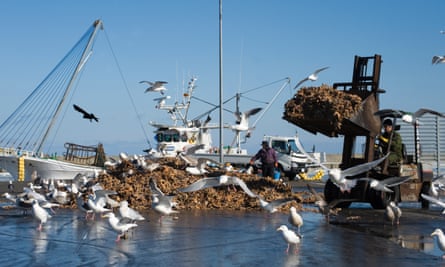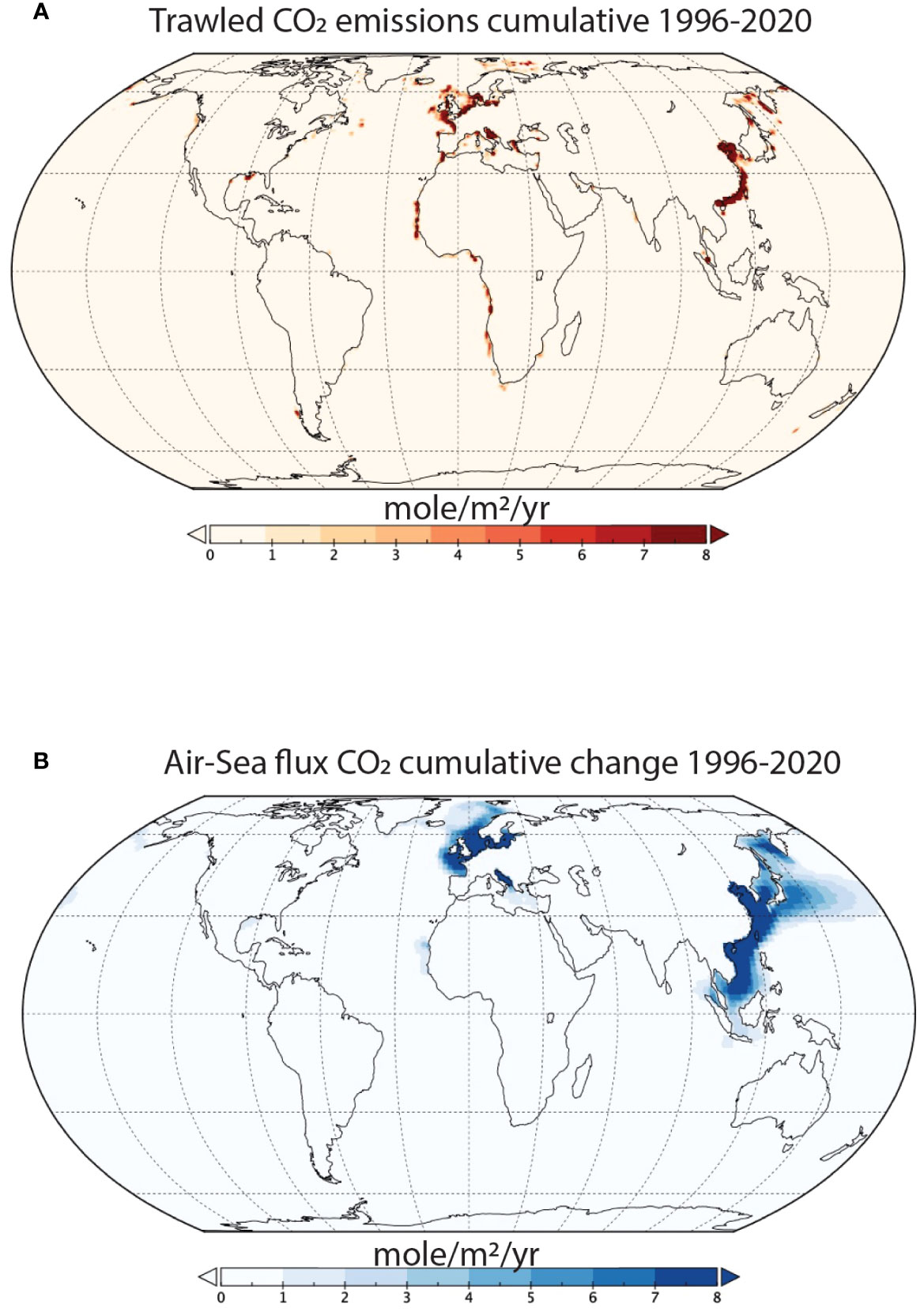Spatial differences in the historical effects of benthic trawling on CO2 emissions. (A) Cumulative emissions of trawled CO2 between 1996-2020. (B) Cumulative changes in the air-sea CO2
flux due to trawling between 1996-2020.
It is important to note that
significant knowledge gaps exist regarding trawling activity in the
Arctic Sea (FAO Area 18), Western Central Pacific (FAO Area 71), and the
Eastern Indian Ocean (FAO Area 57) (Taconet et al., 2019).
Consequently, emissions attributed to trawling in these regions are likely underestimated.
From The Guardian by Karen McVeigh
Fishing nets churn up carbon from the sea floor, more than half of which will eventually be released into the atmosphere
Scientists have long known that bottom trawling – the practice of dragging massive nets along the seabed to catch fish – churns up carbon from the sea floor.
Fishing nets churn up carbon from the sea floor, more than half of which will eventually be released into the atmosphere
Scientists have long known that bottom trawling – the practice of dragging massive nets along the seabed to catch fish – churns up carbon from the sea floor.
Now, for the first time, researchers have calculated just how much trawling releases into the atmosphere: 370m tonnes of planet-heating carbon dioxide a year – an amount, they say, that is “too big to ignore”.
Over the study period, 1996-2020, they estimated the total carbon dioxide released from trawling to the atmosphere to be 8.5 to 9.2bn tonnes.
Over the study period, 1996-2020, they estimated the total carbon dioxide released from trawling to the atmosphere to be 8.5 to 9.2bn tonnes.
The scientists described trawling as “marine deforestation” that causes “irreparable harm” to the climate, society and wildlife.
The study – Atmospheric CO2 emissions and ocean acidification from bottom trawling, written by a global team of climate and ocean experts – found that 55-60% of the carbon dioxide in the water released from the seabed by trawlers will make it to the atmosphere within nine years.
Trawling hotspots in the East China Sea, the Baltic, the North Sea and the Greenland Sea have the largest climate emissions, the study said.
The study – Atmospheric CO2 emissions and ocean acidification from bottom trawling, written by a global team of climate and ocean experts – found that 55-60% of the carbon dioxide in the water released from the seabed by trawlers will make it to the atmosphere within nine years.
Trawling hotspots in the East China Sea, the Baltic, the North Sea and the Greenland Sea have the largest climate emissions, the study said.
Carbon released from the sea floor also causes local acidification, reducing the oceans’ capacity to absorb carbon, the study found.
“We have long known that dragging heavy fishing nets – some as large as 10 747 jets – across the ocean floor destroys sea life and habitats,” said Dr Trisha Atwood, an aquatic ecologist at Utah State University and National Geographic’s Pristine Seas.
“We have long known that dragging heavy fishing nets – some as large as 10 747 jets – across the ocean floor destroys sea life and habitats,” said Dr Trisha Atwood, an aquatic ecologist at Utah State University and National Geographic’s Pristine Seas.
“Only recently, we have discovered that bottom trawling also unleashes plumes of carbon, which otherwise would be safely stored for millennia in the ocean floor.”
Sediment plumes from commercial trawling, not unlike vapour trails left by aircraft, can be seen from space.
The study relied on a vessel-tracking database processed by Global Fishing Watch, which shows where trawling took place in 1996-2020.
Sediment plumes from commercial trawling, not unlike vapour trails left by aircraft, can be seen from space.
The study relied on a vessel-tracking database processed by Global Fishing Watch, which shows where trawling took place in 1996-2020.
They added data on sea-floor carbon, then used three different internationally accepted models of carbon cycles in the ocean, used by the Intergovernmental Panel on Climate Change, to calculate how much carbon released into the water entered the atmosphere.
“Our study is the very first to show that over half the carbon released by bottom trawling eventually escapes into the atmosphere as CO2 over the span of about 10 years, contributing to global warming,” said Atwood.
“Our study is the very first to show that over half the carbon released by bottom trawling eventually escapes into the atmosphere as CO2 over the span of about 10 years, contributing to global warming,” said Atwood.
“Much like destroying forests, scraping up the sea floor causes irreparable harm to the climate, society and wildlife.”

Gulls feeding on dead starfish dumped on the quay from fishing trawlers in Hokkaido, Japan.Photograph: Universal/Getty Images
The research builds on previous work by some team members, published in 2021, which showed that bottom trawling released as much carbon dioxide into the ocean annually as the entire aviation industry, but the fate of the carbon in the water remained an unknown.
The new stud, found that the amount released into the air could double the annual emissions from fuel combustion of the entire global fishing fleet of 4m vessels.
Dr Enric Sala, the explorer-in-residence and executive director of Pristine Seas, said the amount of carbon released by trawling into the air, is “too big to ignore” and urged countries to include the emissions in their climate action plans.
“Countries don’t account for bottom trawling’s significant carbon emissions in their climate action plans,” said Sala. “The good news is that reducing bottom trawling carbon emissions will deliver immediate benefits. The bad news is, delaying action ensures that emissions from trawling will continue seeping into the atmosphere a decade from now.”
The magnitude of trawl-induced carbon dioxide released into water in the original 2021 study – published in Nature and led by Sala – was challenged last year by other scientists, writing in the same journal.
Sala – who said the challenge and its conclusions were based on incorrect assumptions, lacked quantitative support and contained larger uncertainty than his own model – stands by the conclusions of the 2021 paper.
“One thing this new paper shows is that, regardless of the amount of carbon released by bottom trawling, over half will go into the atmosphere within a decade,” Sala said.
The estimates of carbon dioxide released to the atmosphere from trawling are conservative, the researchers said, given they have included only trawlers that are publicly tracked, when a Global Fishing Watch study found that 75% of fishing vessels are not.
Links :

Salon : Trawling for trouble: How fishing along the seafloor significantly worsens climate change
ReplyDelete